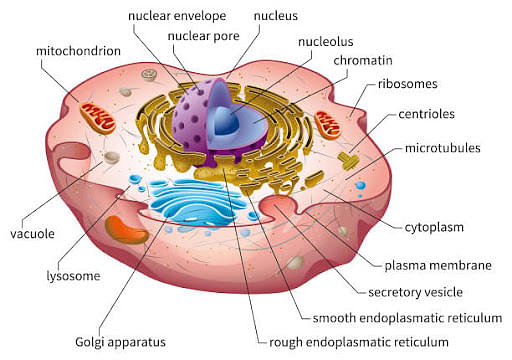Movement and accumulation of ions across a membrane against their concentration gradient can be explained by
Movement and accumulation of ions across a membrane against their concentration gradient can be explained by
Facilitated Diffusion
Passive Transport
Active Transport
Osmosis
The Correct Option is C
Approach Solution - 1
The movement and accumulation of ions across a membrane against their concentration gradient is described by a process known as active transport. Unlike passive transport mechanisms such as facilitated diffusion and osmosis, which rely on the natural kinetic energy of molecules moving down their concentration gradient, active transport requires energy input. This energy is typically provided by ATP (adenosine triphosphate). The process allows cells to maintain concentration differences across membranes, essential for various physiological functions. In summary, active transport is crucial for the uptake of ions and molecules regardless of external concentrations.
Approach Solution -2
Active transport is a cellular process that requires energy (usually in the form of ATP) to move ions or molecules against their concentration gradient, from a region of lower concentration to a region of higher concentration. This process allows cells to maintain specific ion concentrations inside and outside the cell, which is essential for various cellular functions.
Therefore, The correct option is (C): Active Transport
Top Questions on Cell: the unit of life
- Which organelle is primarily responsible for producing ATP in a cell?
- MHT CET - 2025
- Biology
- Cell: the unit of life
- Which organelle in a eukaryotic cell is primarily responsible for synthesizing proteins destined for secretion?
- MHT CET - 2025
- Biology
- Cell: the unit of life
- Which of the following organisms or organelles contain 70S ribosomes?
- MHT CET - 2025
- Biology
- Cell: the unit of life
- Which term is used for cells performing similar functions and cells collecting intracellular material?
- AIIMS - 2024
- Biology
- Cell: the unit of life
- Given below are two statements: Statement I: Cell wall is freely permeable.
Statement II: Plasma membrane is selectively permeable.
Choose the correct answer from the options given below with reference to the structure of root hair:- MHT CET - 2024
- Biology
- Cell: the unit of life
Questions Asked in NEET exam
- Two identical point masses P and Q, suspended from two separate massless springs of spring constants \(k_1\) and \(k_2\), respectively, oscillate vertically. If their maximum velocities are the same, the ratio of the amplitude of P to the amplitude of Q is :
- NEET (UG) - 2025
- Waves and Oscillations
A sphere of radius R is cut from a larger solid sphere of radius 2R as shown in the figure. The ratio of the moment of inertia of the smaller sphere to that of the rest part of the sphere about the Y-axis is :

- NEET (UG) - 2025
- Moment Of Inertia
- A microscope has an objective of focal length \(f_o = 2\) cm and an eyepiece of focal length \(f_e = 4\) cm. The tube length of the microscope is \(L = 40\) cm. If the distance of distinct vision of eye is \(D = 25\) cm, the magnification in the microscope is:
- NEET (UG) - 2025
- Optical Instruments
AB is a part of an electrical circuit (see figure). The potential difference \(V_A - V_B\), at the instant when current \(i = 2\) A and is increasing at a rate of 1 amp/second is:

- NEET (UG) - 2025
- Electromagnetic Induction and Inductance
- Twins are born to a family that lives next door to you. The twins are a boy and a girl. Which of the following must be true?
- NEET (UG) - 2025
- Genetics
Concepts Used:
Cell: The Unit of Life
- A cell is derived as the functional and structural unit of life. Every cell is surrounded by a cell membrane that dissects the external and internal environments of the cell. The interior environment of a cell is called the cytoplasm.
- It carries cellular machinery and structural elements. The nucleus is present in the center of the cell, which includes all the hereditary information of an organism. Some of the molecules present in the cell are protein, carbohydrates, starch, and sugar.
Read More: Fundamental Unit of Life: Cell
Parts of Cell:
The different parts of a cell and their functions are as follows:
- Cell Membrane
- Cell Wall
- Nucleus
- Cytoplasm
